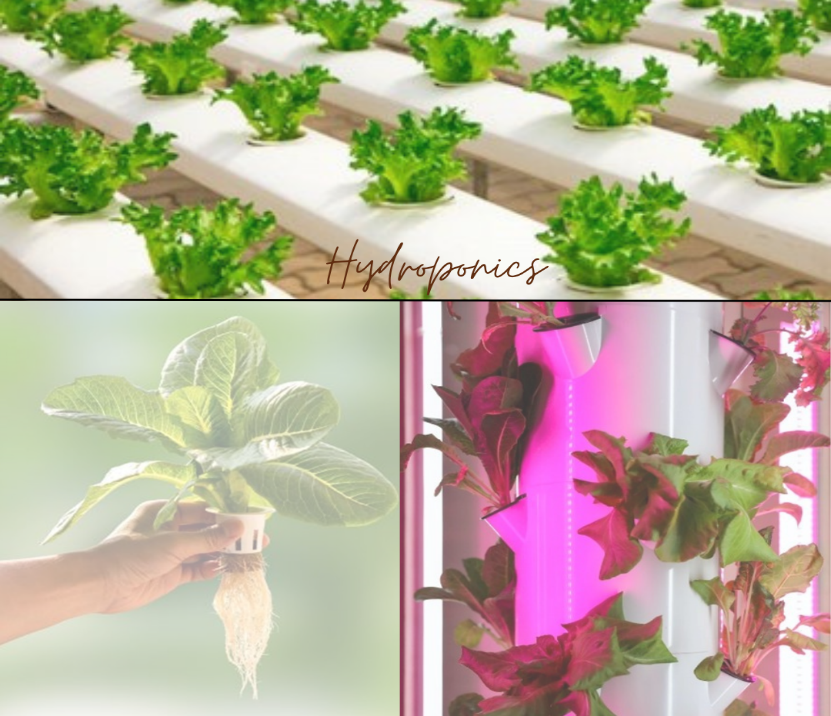Farmers are continuously looking for better and safer ways to cultivate plants while utilising less space since the amount of usable land for crops shrinks due to the rapid increase in population and the need for food. As a result, both small- and large-scale commercial producers are using soilless farming techniques at an unprecedented rate.
At the forefront of soilless systems are both hydroponics and aquaponics, which provide producers multiple significant benefits to growing plants while minimising potentially hazardous environmental effects.
Hydroponics
In hydroponics, plants are grown without soil using a water-based nutrient solution. Growing medium used in this method can include aggregate substrates like vermiculite, coconut coir, or perlite. Small farmers, home gardeners, and commercial enterprises- all use hydroponic production systems.
According to information provided by the United States Department of Agriculture, plant scientists and physiologists studying plant nutrition have used sand or water cultures without soil to grow plants for more than a century. Nutriculture and soilless culture are further names for hydroponics.
Some methods of hydroponic farming include nutrient film technique (NFT), Deep Water Culture (DWC), Wick hydroponics system, EBB & Flow & Drain systems, Drip hydroponics, and Aeroponics.
In India, basil, spinach, lettuce, cucumber, bell peppers, cilantro, and mint are the most commonly produced crops in hydroponic systems.


Advantages of Hydroponic farming systems:
- Sustainably produce enough food today to feed the mankind for the foreseeable future.
- Enabling the reversion of large land areas to their natural state, restoring ecosystem services and functions.
- Utilise the organic material in human and agricultural waste to generate energy through methane generation while also drastically reducing vermin populations (such as rats and cockroaches).
- Take advantage of abandoned and unused urban spaces.
- Permit year-round food production without yield reductions brought on by weather-related or climate-related events.
Disadvantages:
- The cost of the grower’s structure, pumps, tanks, controls like cameras, software, and lighting, along with other expenses, makes the initial setup expensive.
- The various parts of passive and active hydroponics systems, including grow lights, water pumps, aerators, fans, etc., are all powered by electricity. Thus, the entire system will be impacted by a power loss.
- Compared to conventional plant cultivation, hydroponics demands a higher level of oversight and micromanagement. All system components—lights, temperature, and numerous facets of the nutrient solution, such as pH and electrical conductivity—need regular attention to create a meticulously controlled growing environment. To avoid accumulation and clogging, the nutrient solution must also be flushed and changed on a regular basis.
Aquaponics
The terms aquaculture (the practise of cultivating fish in a closed environment) and hydroponics (the growing of plants usually in a soil-less environment) are the roots of the term aquaponics, which refers to the coexistence of plants and fish. Aquaponic systems are available in a range of sizes, including tiny indoor units and huge commercial systems.
There are three primary types of aquaponics system designs: Media bed, Deep water culture (DWC), and Nutrient film technique (NFT). With tomatoes, cucumbers, peppers, melons, flowers, strawberries, and herbs(basil, mint, wheatgrass, chives, oregano, sage, parsley), commercial producers and researchers have experienced considerable success.


Advantages:
- Compared to conventional farming, the yield is around six times higher.
- 90% less water is used in aquaponics than in conventional farming.
- With fish and plants, it offers a double source of income.
- Without the use of any chemicals, the fish and plants are grown organically.
- Fish waste serves as the best natural fertiliser for plants, thus there is no need for any additional fertilisers.
- The cost of running the farm is reduced by aquaponics’ efficient use of resources, less waste, and reusable supplies.
Disadvantages:
- Aquaponics may be excellent for some plants, such as some types of lettuce and tomatoes, but it is not always the best option. For cereals, tubers, and root crops, this approach may not be appropriate.
- Although installing an aquaponics system may initially seem pricey, upgrading the equipment for large-scale production adds a whole new level of expense.
- With the fish giving nutrients for the plants and the plants filtering the water for the fish, aquaponics functions as a closed loop, thus if one component of the loop malfunctions, the entire system will fail.
The primary distinction between hydroponics and aquaponics is that hydroponics involves the cultivation of plants in water, whereas aquaponics involves the use of fish and bacteria in addition to plants.

